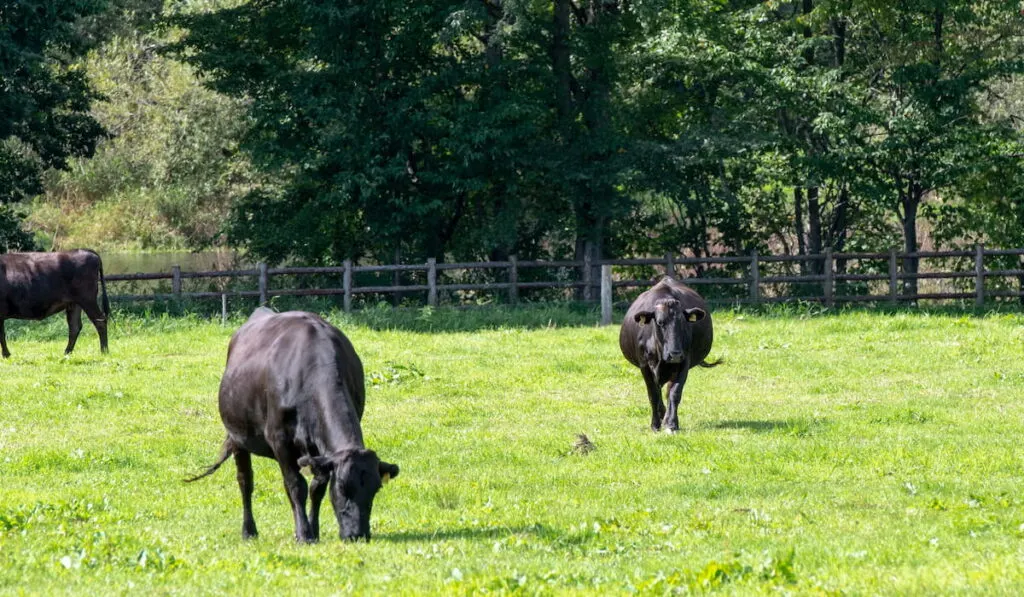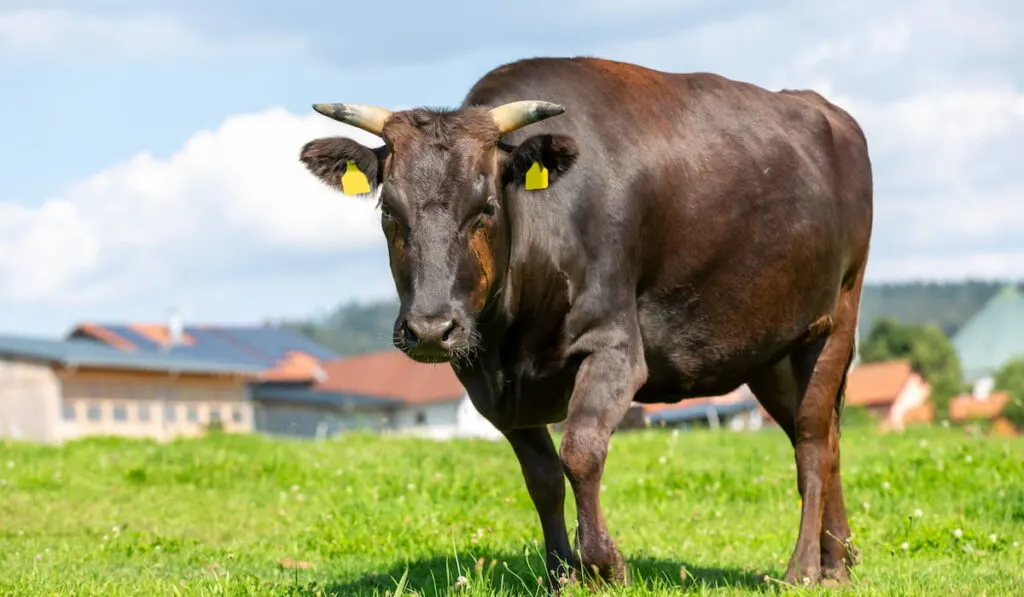If you’re a meat or beef lover, chances are you have heard about wagyu beef and how luxurious or expensive the dishes including this meat are. Depending on your location, the restaurant may put an affordable or astronomical price tag for every piece or pound of this beef.
But what exactly made this type of beef exquisite and different from your local beef? And what does it mean when they call it “wagyu”?
In the simplest term, wagyu is a Japanese word that means “Japanese cattle” or “Japanese-style cattle”. So, wagyu beef is a specific type of beef that comes from Japanese cattle.

There are a few breeds of Japanese cattle that are responsible for producing the wagyu beef that we have today. In this article, we will deeply dive into the history of wagyu beef and how these Japanese cattle found their prominent place in the meat industry and fine dining.
Table of Contents
What are the Four Japanese Breeds of Cattle?
There are four major Japanese breeds of cattle that contribute the most to the wagyu beef industry and beef production. These include:
Japanese Brown Cattle (Kassyoku Washu)
Japanese brown cattle or Japanese red cattle are primarily grown in Shikoku, Kyushu, Kumamoto, and Kochi Prefectures. They are also known as akaushi or akage washu. These cattle are believed to descend from the Korean-born cattle called Hanwoo and the Swiss breed called Simmental.
Depending on these four locations, the cattle have slightly different colors. For instance, cattle raised in Kumamoto Prefecture have light brown skin, while the ones raised in Kochi Prefecture have reddish-brown skin. In Japan, these cattle are raised in mountainous regions and can tolerate hot and cold temperatures.
Japanese brown cattle produce tender and lean meat with low-fat content. People looking to eat healthy meat or trying to watch their fat and cholesterol can opt for this type of meat.
Japanese Black Cattle (Kuroge Washu)
Japanese black cattle are native to southwestern Japan. However, it is believed that the first generation of these cattle was brought from China and raised solely as working animals. Back in the old days, Japanese black cattle were used in rice fields, as transport animals, and for other farming purposes.

These large-sized cattle generally stand between 4 and 5 feet and weigh between 1,129 and 1,784 pounds. There are also four varieties or strains developed from Japanese black cattle, including Tajima, Tottori, Okayama, and Shimane. The beef from these cattle has a buttery taste, tender texture, and strips of fat known as marbling.
Japanese Polled Cattle (Mukaku Washu)
After almost becoming extinct, Japanese polled cattle are still being raised and preserved for the sought-after taste of their lean meat. These cattle were produced in 1920 through a crossbreeding between the Aberdeen Angus breed from Scotland and Japanese black cattle. In Japan, they are primarily developed in Yamaguchi Prefecture.
In 1944, they were recognized as the indigenous breed in Japan. Japanese polled cattle produce meat that contains a high concentration of amino acids. Like their name, you won’t find horns on both sexes.
Japanese Shorthorn Cattle (Nihon Takankushu)
The Japanese shorthorn cattle are developed from a crossbreeding between the native breed, Nanbu, and the Shorthorn. In Japan, these cattle are raised primarily in the Tohoku, Hokkaido, and northern Honshu. These cows also come in different color variations, including red, red-pied, and roan.

Unlike the Japanese polled cattle, both sexes of this breed possess horns. They are highly tolerant of cold and hot environments and were certified as indigenous Japanese cattle in 1957. Japanese shorthorn cattle also produce high-quality, lean red meat that is rich in glutamic and inosinic acid.
What Types of Cows are in Japan?
Aside from those four major Japanese breeds, there are also a few other Japanese cows that you might not have heard of. These include:
Mishiwa Cow
Unlike other wagyu cattle, Mishiwa cows, or Mishima-ushi, are considered an endangered species that is native to Mashima Islands in Yamaguchi Prefecture. They are considered purebred, indigenous Japanese cows that have never been crossbred with other foreign breeds.
They are also believed to be the original native Japanese cattle that descend from cattle in China. These cows stand between 3.8 and 4.1 feet and weigh between 882 and 1,322 pounds. The remaining population of 108 cows is being conserved and raised mainly for their meat.
Kuchinoshima Cow
Kuchinoshimas are one of the few endangered and nearly extinct cattle that exist in Japan. They are exclusively found and raised in southern Japan, specifically on Kuchinoshima Island. These cows stand between 3.3 and 3.6 feet and weigh around 882 pounds. Similar to the Mishiwa breed, they have never been crossbred with other breeds and are raised mainly for their meat.

Are Japanese Cows Different?
Japanese cows, specifically wagyu breeds, produce a different quality of meat compared to other domestic cows and cattle. In fact, most wagyu cows are raised solely for the purpose of meat production.
In Japan, you can find other types of domestic cows, and most of them are imported breeds. Some of these imported cows aren’t suited to be raised for high-quality wagyu meat. Therefore, they are being kept mainly for milk and if possible, for both milk and low or medium-quality meat.
One of the reasons why wagyu cows are different from your usual breeds is the texture and tenderness of their meat. They have a high concentration of good fat and fatty acids such as Omega-3 and 6, monosaturated fats, and conjugated linoleic acid (CLA), all of which can be found on the white strips known as marblings. This also contributes to the meat’s delicate, meaty, and buttery taste.
Most wagyu cows are also raised in a strictly controlled, clean, and pasteurized environment. For instance, breeders will keep these cows near mountainous regions, away from cities and other developed regions. In this type of environment, they are fed with clean grass and kept organically clean from any contamination and polluted source of feed.
Hence, you can be sure that their meat is much healthier and more expensive compared to other types of cows.

Do Japanese Cows Exist in the United States?
Most of the Japanese cows that are being raised in the United States come directly from Japan. However, back in the old days, most wagyu cows were being imported from Japan before the United States stopped the import in 2003 due to the outbreak of mad cow diseases.
Since then, the United States has been breeding and raising its own wagyu cattle, focusing mainly on black and red wagyu cattle. But in 1990, the American Wagyu Association was founded and they are responsible for monitoring, regulating, and registering all wagyu cattle and beef that you can find today.
You can also visit their website for more information on how wagyu beef is being graded in the United States and all the qualifications or necessities required to breed this type of cow.
Final Thoughts
Japanese cattle and their meat are exquisite and healthy compared to other meat. Of course, you have to deal with the hefty price tag for different grades of wagyu beef. But at the end of the day, you get what you pay for. If possible, you should taste wagyu beef at least once in your life, so you’ll know why it is labeled as the highest quality, prime beef.
Resources
- http://afs.okstate.edu/breeds/cattle/wagyu/index.html/
- https://wagyu.org/breed-info/what-is-wagyu
- https://www.foodandwine.com/meat-poultry/beef/wagyu-beef-why-its-so-expensive
- https://www.thecattlesite.com/breeds/beef/49/wagyu/
- https://www.agdaily.com/livestock/facts-about-japanese-wagyu-cattle/
- https://en.wikipedia.org/wiki/Japanese_Black
- https://en.wikipedia.org/wiki/Japanese_Polled
- https://twinwoodcattle.com/breed-history/wagyu-history-japan
- https://wagyu.org/breed-info/
- https://www.tokyofoundation.org/research/detail.php?id=256
- https://en.wikipedia.org/wiki/Mishima_cattle
- https://blackmoremishima.com/
- https://www.visit-kyushu.com/en/see-and-do/gourmet-kyushu/raising-kumamotos-famed-japanese-brown-cattle/
- https://en.wikipedia.org/wiki/Japanese_Brown
- http://www3.jmi.or.jp/en/about.html
- https://wagyu.org/
